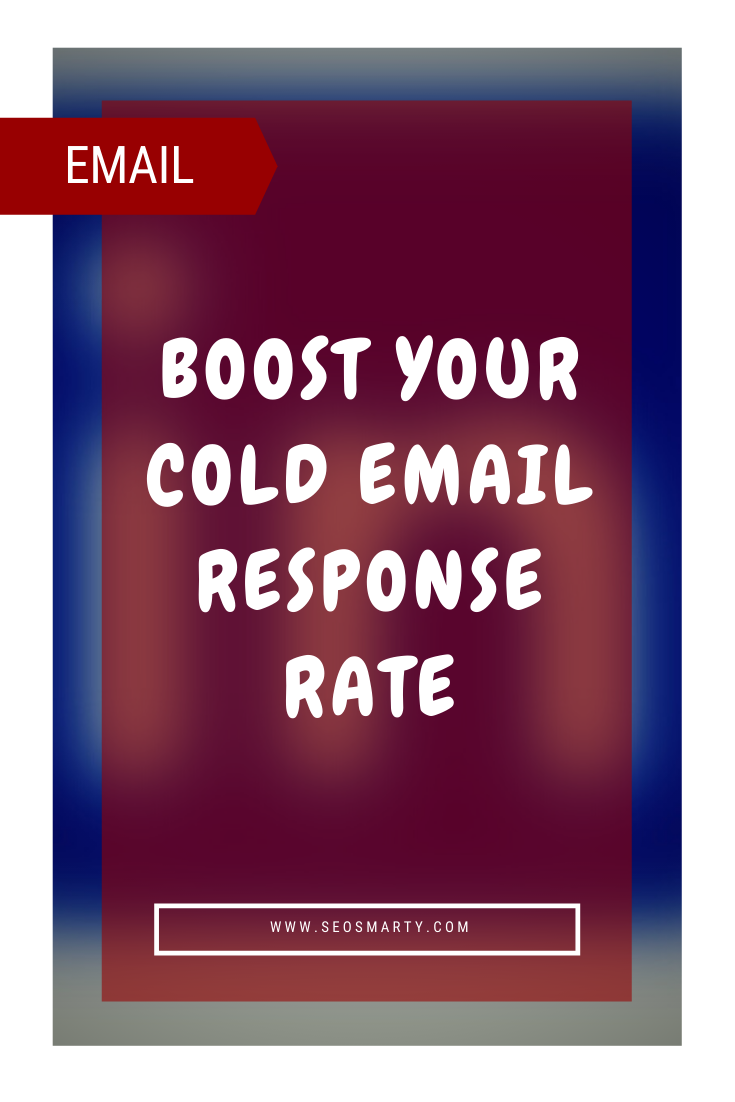SEO
How to Boost Your Cold Email Response Rate

When your email response rates seem to be persistently low, it can be extremely frustrating. You keep tweaking things, but the results don’t seem to change.
There are steps you can take to boost your cold email response rate, though. With careful planning, you can make a huge difference to the success of your campaigns.
Here are twelve steps you can take to boost your cold email response rate.
Personalization Is Key
We all value our inboxes. We use them to organize our businesses, our personal lives, and everything in between.
If we’re to allow emails into our inboxes, then they have to add value.;
In a world of constant spam, we’re extremely adept at scanning through our emails and discarding the worthless ones. Unfortunately, this makes it harder for your cold outreach – even if you’re offering exceptional value.
One way to quickly showcase that you’re different from the spam and that you actually offer value is through personalization.
It’s very difficult to offer value through an email without personalization. It’s even harder to convey value without personalization.
We’re constantly on the lookout for spam and one of the first signs is that an email could have gone out to anybody. Show that you’ve put the time into understanding the prospect and that your email offers value.
Some ideas for increased personalization can range from starting the mail with the lead’s name and all the way to incorporating email signature marketing in your cold email campaign, which will help you reach a higher conversion rate of your leads.
Personalized emails drive 6x more transactions, and it’s not surprising.
Research Your Prospects to Make Your Emails More Relevant
When we talk about personalization, we’re talking about more than just putting someone’s name in the subject line and first sentence.
We’re talking about understanding the motivations of your prospects. This takes a little bit of extra effort, but it pays off:
- Spend time on your prospect list and ensure your prospects’ goals are closely aligned to what you’re offering.
- Find out what they’re talking about/sharing and show that you care about the same things by referencing them in the email.
- Research prospects on social media (outreach software like Mailshake offers LinkedIn plugins to make this easier) and use a tool like Voila Norbert to find specific emails for people in that organization.

Use Voilanorbert to find contact details of just about anyone
Information is a way to create a connection. It takes more work, but it will make your cold outreach much more effective.
Make Your Subject Lines Stand Out
Before you can even dream of getting a response, you need to get your email noticed in a crowded inbox.
It’s estimated that the average worker sends and receives 121 business emails each day. If we take that number, then your subject line has to compete with 120 other subject lines.
This is a split-second opportunity to pique someone’s interest that you can’t afford to miss.
It’s a tricky balance because you need to grab someone’s attention while staying on point and conveying value. 47% of recipients decide whether or not to open emails based on the subject alone, so this goes to show the importance of choosing the right words.
Make sure you’re dedicating plenty of energy to creating subject lines that stand out.
Respect the Prospect’s Time
People lead busy lives. Whether they’re at work or at leisure, they don’t want to be wasting their time reading long emails with no guarantee of value.
Your emails have to respect your prospect’s time by getting to the point.
It’s natural to want to try and fit as much information in about your product as possible, but you should taper this. Instead, focus on using your creativity to create concise, value-packed emails that grab your audience’s attention.
Don’t forget about the presentation either – break up the paragraphs to make them easy to read and make sure it looks like something that’s going to be a quick read.
Focus on the Prospect’s Needs – You’re not the Focus
You’re a great company with a great product – it’s easy to start waxing lyrical about your business to try and impress your prospect.
You have to remember that the prospect never asked for your email, though. They’ve shown no interest in your business, but they do have an interest in their own success.
This means you have to put your interests on the backburner and showcase how you can address the prospect’s needs. Your cold emails aren’t about making a sale there and then; they’re about starting a conversation, so how can you achieve this?
Use a Proven Sales Pitch
Cold pitching is nothing new, and the psychology of sales applies to cold emails just as it does any other sales interaction.
People have been selling things for a long time now, and they’ve found there are certain things that work and others that don’t. A lot of the hard work has been done for you, and there are some tried and tested sales pitches you can incorporate into your cold emails.
Yes, you will adapt them, but the principles of selling remain the same, and these sales pitches work.
Often, you don’t have to reinvent the wheel. You just have to find a way to make it work for your specific needs.
Perfect Your Copy
You can have a great strategy for getting more responses but if you can’t accurately convey your messages, then they’re not going to work. Just like with your subject lines, there’s a tough balancing act to achieve.
You should:
- Convey value
- Be concise
- Infuse character
- Engage your audience
This is why it pays to take your time over your emails. Think about your language and how it might be received by your prospects. Changing a few words in your copy can make a difference to your response rate, so make sure to A/B test as you go.
Your subject lines may grab your prospects’ attention, but your copy needs to hold it. Don’t be shy of running a few iterations with your copywriter or copywriting service.
Discover Your Brand Voice
Don’t be afraid to show your character in your email!
One thing you notice with spam is how bland it is – there’s no character in it, no brand voice. This fits the theme of a general lack of personalization. Poor cold emails give you nothing to be excited about and nothing to identify with.
Character grabs people’s attention and makes you stand out from all the other emails.
Your business has its own unique identity and story, so make sure you infuse this into your emails. Develop your brand voice and make it tell your story.
Character is an important part of any marketing. Just because emails are short shouldn’t mean they’re any less characterful. Use your brand voice to get people to interact with your cold emails.
Incorporate Multimedia
Multimedia is great for grabbing people’s attention and efficiently conveying complex messages. Viewers retain 95% of the message when watching a video versus 10% when reading text.
In a cold email, you want to get your key points across quickly, so this makes video ideal.
The big thing to remember is you have to keep an eye on deliverability. Email providers have complex algorithms to detect spam, and multimedia will play into this. If you’re working with a good sales engagement platform, then they will help you manage your deliverability, but it’s important you’re not overloading your emails.
Optimize Your Calls to Action
It’s amazing the impact a good call to action can have. Emails with a single call-to-action have been found to increase clicks by 371% and sales by 1617%.
When you’re writing your copy it’s always obvious to you what action you want people to take. For the reader, it’s not always so obvious. If you want people to take action, then you have to lead them towards it, and that’s exactly what your CTAs do.
For instance, if you host webinars, you can drive people to a landing page where they can sign up to attend the webinar itself and then, depending on what webinar platform you use, you can use the platform to send them notifications and use calls to action in the webinar to drive them into your sales funnel.
Your CTAs help tie everything together and show the prospect what you want them to do next. Any old CTA won’t do; they need to be optimized, so make sure you’re A/B testing.
Build Out Your Sequences
People don’t always respond to your email the first time around – this doesn’t mean you should give up.
There are lots of reasons why people might not respond to you after the first email but will respond to subsequent ones. How often do we forget to respond to an important email in our personal lives? Well, responding to your email might be of secondary importance to someone and sometimes it slips through the cracks.
This means it’s important to be persistent.
If you’re offering value, then there’s nothing wrong with sending more emails and creating a sequence. The key is respecting your prospects’ privacy and knowing when enough is enough.
Automation and Testing
Checking off every detail in this list is no easy task. There’s a lot of work involved, and when you’re running big campaigns you want to automate as much as possible.
This is where software like Mailshake is worth its weight in gold.
When you’re creating campaigns, you want everything to be in one place, and make your life as simple as possible. With built-in sequences, A/B testings, social media plugins, automated responses, and powerful personalization tools, that’s exactly what Mailshake offers.
Detailed statistics help you maximize deliverability, get your emails opened, and push up your response rates.
With the right software, ticking off all the tips on this list becomes much easier.
Final Thoughts
A good response rate is vital if you’re going to see a good return on investment from your cold email campaigns. Luckily, there are lots of little steps you can take to achieve this.
The difficulty with cold emails is that they’re used so poorly by so many. This makes it even more difficult for the people that are doing it well.
What you need to do is take care of the small details and think about the recipient first. If you can demonstrate you offer value at every step of the interaction, then it’s going to give you a much better chance.
With a few tweaks, you can give your email response rates a big boost.
Source link
SEO
brightonSEO Live Blog

Hello everyone. It’s April again, so I’m back in Brighton for another two days of Being the introvert I am, my idea of fun isn’t hanging around our booth all day explaining we’ve run out of t-shirts (seriously, you need to be fast if you want swag!). So I decided to do something useful and live-blog the event instead.
Follow below for talk takeaways and (very) mildly humorous commentary. sun, sea, and SEO!
SEO
Google Further Postpones Third-Party Cookie Deprecation In Chrome

Google has again delayed its plan to phase out third-party cookies in the Chrome web browser. The latest postponement comes after ongoing challenges in reconciling feedback from industry stakeholders and regulators.
The announcement was made in Google and the UK’s Competition and Markets Authority (CMA) joint quarterly report on the Privacy Sandbox initiative, scheduled for release on April 26.
Chrome’s Third-Party Cookie Phaseout Pushed To 2025
Google states it “will not complete third-party cookie deprecation during the second half of Q4” this year as planned.
Instead, the tech giant aims to begin deprecating third-party cookies in Chrome “starting early next year,” assuming an agreement can be reached with the CMA and the UK’s Information Commissioner’s Office (ICO).
The statement reads:
“We recognize that there are ongoing challenges related to reconciling divergent feedback from the industry, regulators and developers, and will continue to engage closely with the entire ecosystem. It’s also critical that the CMA has sufficient time to review all evidence, including results from industry tests, which the CMA has asked market participants to provide by the end of June.”
Continued Engagement With Regulators
Google reiterated its commitment to “engaging closely with the CMA and ICO” throughout the process and hopes to conclude discussions this year.
This marks the third delay to Google’s plan to deprecate third-party cookies, initially aiming for a Q3 2023 phaseout before pushing it back to late 2024.
The postponements reflect the challenges in transitioning away from cross-site user tracking while balancing privacy and advertiser interests.
Transition Period & Impact
In January, Chrome began restricting third-party cookie access for 1% of users globally. This percentage was expected to gradually increase until 100% of users were covered by Q3 2024.
However, the latest delay gives websites and services more time to migrate away from third-party cookie dependencies through Google’s limited “deprecation trials” program.
The trials offer temporary cookie access extensions until December 27, 2024, for non-advertising use cases that can demonstrate direct user impact and functional breakage.
While easing the transition, the trials have strict eligibility rules. Advertising-related services are ineligible, and origins matching known ad-related domains are rejected.
Google states the program aims to address functional issues rather than relieve general data collection inconveniences.
Publisher & Advertiser Implications
The repeated delays highlight the potential disruption for digital publishers and advertisers relying on third-party cookie tracking.
Industry groups have raised concerns that restricting cross-site tracking could push websites toward more opaque privacy-invasive practices.
However, privacy advocates view the phaseout as crucial in preventing covert user profiling across the web.
With the latest postponement, all parties have more time to prepare for the eventual loss of third-party cookies and adopt Google’s proposed Privacy Sandbox APIs as replacements.
Featured Image: Novikov Aleksey/Shutterstock
SEO
How To Write ChatGPT Prompts To Get The Best Results

ChatGPT is a game changer in the field of SEO. This powerful language model can generate human-like content, making it an invaluable tool for SEO professionals.
However, the prompts you provide largely determine the quality of the output.
To unlock the full potential of ChatGPT and create content that resonates with your audience and search engines, writing effective prompts is crucial.
In this comprehensive guide, we’ll explore the art of writing prompts for ChatGPT, covering everything from basic techniques to advanced strategies for layering prompts and generating high-quality, SEO-friendly content.
Writing Prompts For ChatGPT
What Is A ChatGPT Prompt?
A ChatGPT prompt is an instruction or discussion topic a user provides for the ChatGPT AI model to respond to.
The prompt can be a question, statement, or any other stimulus to spark creativity, reflection, or engagement.
Users can use the prompt to generate ideas, share their thoughts, or start a conversation.
ChatGPT prompts are designed to be open-ended and can be customized based on the user’s preferences and interests.
How To Write Prompts For ChatGPT
Start by giving ChatGPT a writing prompt, such as, “Write a short story about a person who discovers they have a superpower.”
ChatGPT will then generate a response based on your prompt. Depending on the prompt’s complexity and the level of detail you requested, the answer may be a few sentences or several paragraphs long.
Use the ChatGPT-generated response as a starting point for your writing. You can take the ideas and concepts presented in the answer and expand upon them, adding your own unique spin to the story.
If you want to generate additional ideas, try asking ChatGPT follow-up questions related to your original prompt.
For example, you could ask, “What challenges might the person face in exploring their newfound superpower?” Or, “How might the person’s relationships with others be affected by their superpower?”
Remember that ChatGPT’s answers are generated by artificial intelligence and may not always be perfect or exactly what you want.
However, they can still be a great source of inspiration and help you start writing.
Must-Have GPTs Assistant
I recommend installing the WebBrowser Assistant created by the OpenAI Team. This tool allows you to add relevant Bing results to your ChatGPT prompts.
This assistant adds the first web results to your ChatGPT prompts for more accurate and up-to-date conversations.
It is very easy to install in only two clicks. (Click on Start Chat.)
For example, if I ask, “Who is Vincent Terrasi?,” ChatGPT has no answer.
With WebBrower Assistant, the assistant creates a new prompt with the first Bing results, and now ChatGPT knows who Vincent Terrasi is.
 Screenshot from ChatGPT, March 2023
Screenshot from ChatGPT, March 2023You can test other GPT assistants available in the GPTs search engine if you want to use Google results.
Master Reverse Prompt Engineering
ChatGPT can be an excellent tool for reverse engineering prompts because it generates natural and engaging responses to any given input.
By analyzing the prompts generated by ChatGPT, it is possible to gain insight into the model’s underlying thought processes and decision-making strategies.
One key benefit of using ChatGPT to reverse engineer prompts is that the model is highly transparent in its decision-making.
This means that the reasoning and logic behind each response can be traced, making it easier to understand how the model arrives at its conclusions.
Once you’ve done this a few times for different types of content, you’ll gain insight into crafting more effective prompts.
Prepare Your ChatGPT For Generating Prompts
First, activate the reverse prompt engineering.
- Type the following prompt: “Enable Reverse Prompt Engineering? By Reverse Prompt Engineering I mean creating a prompt from a given text.”
 Screenshot from ChatGPT, March 2023
Screenshot from ChatGPT, March 2023ChatGPT is now ready to generate your prompt. You can test the product description in a new chatbot session and evaluate the generated prompt.
- Type: “Create a very technical reverse prompt engineering template for a product description about iPhone 11.”
 Screenshot from ChatGPT, March 2023
Screenshot from ChatGPT, March 2023The result is amazing. You can test with a full text that you want to reproduce. Here is an example of a prompt for selling a Kindle on Amazon.
- Type: “Reverse Prompt engineer the following {product), capture the writing style and the length of the text :
product =”
 Screenshot from ChatGPT, March 2023
Screenshot from ChatGPT, March 2023I tested it on an SEJ blog post. Enjoy the analysis – it is excellent.
- Type: “Reverse Prompt engineer the following {text}, capture the tone and writing style of the {text} to include in the prompt :
text = all text coming from https://www.searchenginejournal.com/google-bard-training-data/478941/”
 Screenshot from ChatGPT, March 2023
Screenshot from ChatGPT, March 2023But be careful not to use ChatGPT to generate your texts. It is just a personal assistant.
Go Deeper
Prompts and examples for SEO:
- Keyword research and content ideas prompt: “Provide a list of 20 long-tail keyword ideas related to ‘local SEO strategies’ along with brief content topic descriptions for each keyword.”
- Optimizing content for featured snippets prompt: “Write a 40-50 word paragraph optimized for the query ‘what is the featured snippet in Google search’ that could potentially earn the featured snippet.”
- Creating meta descriptions prompt: “Draft a compelling meta description for the following blog post title: ’10 Technical SEO Factors You Can’t Ignore in 2024′.”
Important Considerations:
- Always Fact-Check: While ChatGPT can be a helpful tool, it’s crucial to remember that it may generate inaccurate or fabricated information. Always verify any facts, statistics, or quotes generated by ChatGPT before incorporating them into your content.
- Maintain Control and Creativity: Use ChatGPT as a tool to assist your writing, not replace it. Don’t rely on it to do your thinking or create content from scratch. Your unique perspective and creativity are essential for producing high-quality, engaging content.
- Iteration is Key: Refine and revise the outputs generated by ChatGPT to ensure they align with your voice, style, and intended message.
Additional Prompts for Rewording and SEO:
– Rewrite this sentence to be more concise and impactful.
– Suggest alternative phrasing for this section to improve clarity.
– Identify opportunities to incorporate relevant internal and external links.
– Analyze the keyword density and suggest improvements for better SEO.
Remember, while ChatGPT can be a valuable tool, it’s essential to use it responsibly and maintain control over your content creation process.
Experiment And Refine Your Prompting Techniques
Writing effective prompts for ChatGPT is an essential skill for any SEO professional who wants to harness the power of AI-generated content.
Hopefully, the insights and examples shared in this article can inspire you and help guide you to crafting stronger prompts that yield high-quality content.
Remember to experiment with layering prompts, iterating on the output, and continually refining your prompting techniques.
This will help you stay ahead of the curve in the ever-changing world of SEO.
More resources:
Featured Image: Tapati Rinchumrus/Shutterstock
-

 PPC6 days ago
PPC6 days ago19 Best SEO Tools in 2024 (For Every Use Case)
-
SEARCHENGINES6 days ago
Daily Search Forum Recap: April 19, 2024
-
SEARCHENGINES7 days ago
Daily Search Forum Recap: April 18, 2024
-

 WORDPRESS6 days ago
WORDPRESS6 days agoHow to Make $5000 of Passive Income Every Month in WordPress
-

 WORDPRESS7 days ago
WORDPRESS7 days ago10 Amazing WordPress Design Resouces – WordPress.com News
-

 SEO6 days ago
SEO6 days ago25 WordPress Alternatives Best For SEO
-

 WORDPRESS6 days ago
WORDPRESS6 days ago7 Best WooCommerce Points and Rewards Plugins (Free & Paid)
-

 MARKETING5 days ago
MARKETING5 days agoBattling for Attention in the 2024 Election Year Media Frenzy
















You must be logged in to post a comment Login